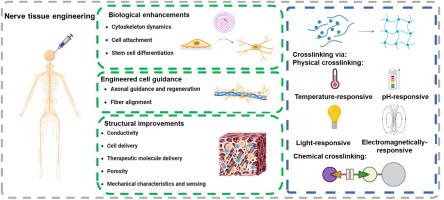神经修复用智能水凝胶的研究进展:标准及应用综述
IF 6.8
3区 材料科学
Q1 MATERIALS SCIENCE, MULTIDISCIPLINARY
Journal of Science: Advanced Materials and Devices
Pub Date : 2025-09-01
DOI:10.1016/j.jsamd.2025.100996
引用次数: 0
摘要
由于智能水凝胶能够模拟细胞外基质(ECM)并以可控的方式输送治疗剂,因此它正在成为神经组织工程中非常有前途的生物材料。这篇综述特别强调了智能水凝胶的关键选择标准,包括机械性能、降解率、电导率、生物相容性以及对生化或物理刺激的反应性。最近的研究证据表明,导电和生物活性水凝胶可增强神经元分化和轴突引导,而注射制剂可促进微创中枢神经系统(CNS)和周围神经系统(PNS)的修复。当前的挑战包括确保一致的性能、监管批准以及从小型动物模型到大型动物模型的转换。最后,该综述确定了未来的研究方向,例如开发适应局部炎症的适应性水凝胶,优化药物和细胞递送,以及基于患者特异性遗传学推进个性化水凝胶疗法,旨在指导该领域走向临床可翻译的神经再生解决方案。本文章由计算机程序翻译,如有差异,请以英文原文为准。

Advances in smart hydrogels for nerve repair: A review focusing on criteria and applications
Smart hydrogels are emerging as highly promising biomaterials for nerve tissue engineering due to their ability to mimic the extracellular matrix (ECM) and deliver therapeutic agents in a controlled manner. This review specifically highlights key selection criteria for smart hydrogels, including mechanical properties, degradation rate, electrical conductivity, biocompatibility, and responsiveness to biochemical or physical stimuli. Evidence from recent studies shows that conductive and bioactive hydrogels enhance neuron differentiation and axon guidance, while injectable formulations facilitate minimally invasive central nervous system (CNS) and peripheral nervous system (PNS) repair. Current challenges include ensuring consistent performance, regulatory approval, and translation from small to large-animal models. Finally, the review identifies future research directions, such as developing adaptive hydrogels that respond to local inflammation, optimizing drug and cell delivery, and advancing personalized hydrogel therapies based on patient-specific genetics, aiming to guide the field toward clinically translatable neural regeneration solutions.
求助全文
通过发布文献求助,成功后即可免费获取论文全文。
去求助
来源期刊

Journal of Science: Advanced Materials and Devices
Materials Science-Electronic, Optical and Magnetic Materials
CiteScore
11.90
自引率
2.50%
发文量
88
审稿时长
47 days
期刊介绍:
In 1985, the Journal of Science was founded as a platform for publishing national and international research papers across various disciplines, including natural sciences, technology, social sciences, and humanities. Over the years, the journal has experienced remarkable growth in terms of quality, size, and scope. Today, it encompasses a diverse range of publications dedicated to academic research.
Considering the rapid expansion of materials science, we are pleased to introduce the Journal of Science: Advanced Materials and Devices. This new addition to our journal series offers researchers an exciting opportunity to publish their work on all aspects of materials science and technology within the esteemed Journal of Science.
With this development, we aim to revolutionize the way research in materials science is expressed and organized, further strengthening our commitment to promoting outstanding research across various scientific and technological fields.
 求助内容:
求助内容: 应助结果提醒方式:
应助结果提醒方式:


